 |
||
|
||
Picketing Spa Creek Bridge for PeaceThree and a half years in, a faithful pair still bear witness
by Adrienne KasperAs Spa Creek Bridge bursts with traffic, a pair of war protesters bear messages of peace. They are Annapolis and Eastport’s span of Bridges for Peace, a grassroots movement that began on one bridge in Maine, spreading to 32 bridges there, as well as to Vermont, New Hampshire and Maryland, where a bridge over Stoney Creek in Pasadena is also a span in the movement. On March 1 of 2003, Eastportorican Sigrid Trumpy organized the Spa Creek span to protest what was then only the threat of war. “I wanted to achieve the impossible and stop the war,” Trumpy said. “I need people to stand with me, to hold signs of their own thoughts, such as peace or anything else that is meaningful to you, or to just be there,” Trumpy’s initial letter read. Three and a half war years and 2,837 American deaths later, protestors still march. As the war rages on and people’s day-to-day life takes a front seat, the number of people lining the bridge each Sunday has diminished from the original 30. But for Lucy Oppenheim and Dick Vanden Heuvel, opposition to this administration’s policies is now needed more than ever. “It’s about not submitting quietly to the terrible policies of the government now,” Oppenheim said. The policies “are so wrong that I’ve got to raise up my voice.” Oppenheim and Vanden Heuvel, sometimes only one, have kept vigil every Sunday from noon to 1pm, reaching those who may not be willing to listen but can’t help but stare. “All we can do is try to increase public awareness that the U.S. needs to get out of Iraq,” Vanden Heuvel said. “The sooner it happens, the better because our troops over there are actually increasing the violence rather than decreasing it.” As Oppenheim walks back and forth across the bridge, people bump into her, some apologetic, others too rushed to notice. She continues on her rounds, carrying the sign she has had since the vigil began: Hands off Venezuela, Syria and Iran. “It is always about Iraq,” Oppenheim said. “But beyond that, each person involved has a different take on which of the administration’s policies could be changed.” Vanden Heuvel remains in place on the other side, waving his sign opposing the U.S. in Haiti, eager to talk to any who stop. In their weekly vigil, Oppenheim and Vanden Heuvel are not overlooked. Hand signals are by far the most frequent response. Increasingly, more are approving than disapproving. Either way, Oppenheim and Vanden Heuvel are undaunted, knowing that they open eyes, if just in passing. Turnout on the bridge rises on anniversaries, but for the most part, these dedicated two keep the span unbroken. Oppenheim and Vanden Heuvel say they will meet on the bridge until policies are changed. “I feel that this is one of the few ways that I can express myself to try to change U.S. policy,” Vanden Heuvel said. “I will be out here every Sunday as long as it is necessary. Slowly, sentiment is changing over. On Election Day, people were voting about the war.” Adrienne Kaspar, of Severna Park, is a junior studying journalism at the University of Maryland. This is her first story for Bay Weekly. |
||
|
|
||
|
© COPYRIGHT 2004 by New Bay Enterprises, Inc. All rights reserved. |

